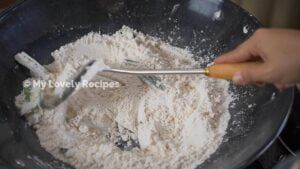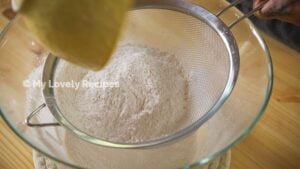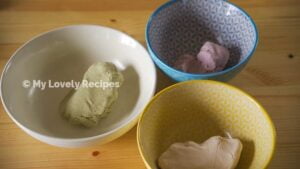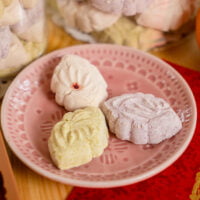Kuih Bangkit
some people call it Kueh Bangkek, and the Chinese name is Fan Po Bing or Coconut Cookies. It tastes very dry, but it melts in the mouth and has a full coconut fragrance.
Servings: 60 pieces
Calories: 25kcal
Equipment
- Kuih Bangkit Mold
Ingredients
- 240 g Sago Starch fried
- 1 Egg Yolk about 18g
- 60 g Icing Sugar
- 80 g Concentrated Coconut Cream
- 0.25 tsp Salt
- 1 tsp Purple Sweet Potato Powder
- 2 tsp Pandan Powder
- 3 pcs Pandan Leaves
Instructions
- Wipe the pandan leaves dry and cut them into small pieces, put them in a pot and pour sago starch, stir-fry them over low heat until the pandan leaves can be crushed, and let them cool for later use.

- Pour the coconut cream into the pot and boil it over low heat until the bubbles are in a lava state, then turn off the heat and let it cool for later use.

- Beat the egg yolks, icing sugar, and salt with a whisk at low speed until the color becomes lighter and smooth.

- Add the cooled concentrated coconut cream and mix well with a whisk at low speed.

- Sift and add the fried sago starch and stir evenly until mixed well.

- The dough can be divided and added with different flavors and amounts of plant powder according to personal preference. If the dough is too dry, add a little concentrated coconut cream, otherwise, add a little powder.

- After spreading the fried sago starch on the baking tray and mold, then knocking out the excess powder in the mold, press the dough into the mold forcefully. Cut off the excess dough and knock it out.

- Put the Kuih Bangkit in the middle rack of the oven and bake them at 160 degrees Celsius for 28 minutes.

- After baking, let it cool before putting it in a container.

Video
Nutrition
Serving: 1piece | Calories: 25kcal | Carbohydrates: 5.4g | Protein: 0.1g | Fat: 0.3g | Saturated Fat: 0.2g | Cholesterol: 3mg | Sodium: 13mg | Potassium: 2mg | Sugar: 1.7g
